Poverty: A Societal Issue, Recommendations, and Ethical Challenges
VerifiedAdded on 2022/09/15
|6
|1219
|31
Essay
AI Summary
This essay examines poverty as a significant societal issue, exploring its multifaceted nature and impact on individuals and communities. It identifies entrepreneurship and redistribution of national public expenditures as potential strategies for poverty reduction. The essay delves into the ethical challenges associated with these recommendations, such as the need for initial investments in entrepreneurship and the potential for biased resource allocation. It proposes strategies to address these ethical concerns, including promoting entrepreneurial growth through investments and implementing strict accountability and transparency measures in resource distribution. The essay underscores the importance of equitable practices and policies to effectively address poverty and its related ethical dilemmas.
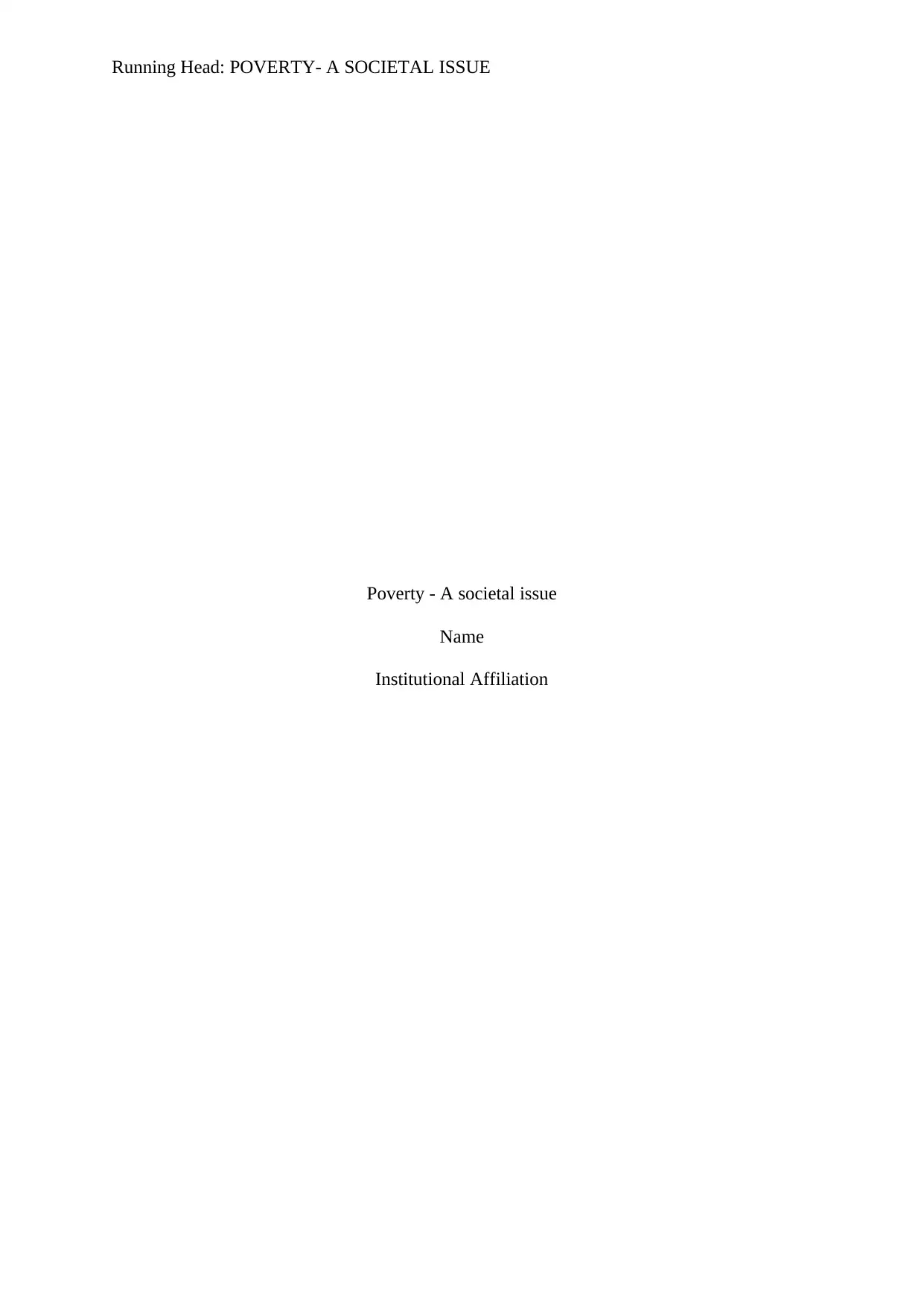
Running Head: POVERTY- A SOCIETAL ISSUE
Poverty - A societal issue
Name
Institutional Affiliation
Poverty - A societal issue
Name
Institutional Affiliation
Paraphrase This Document
Need a fresh take? Get an instant paraphrase of this document with our AI Paraphraser
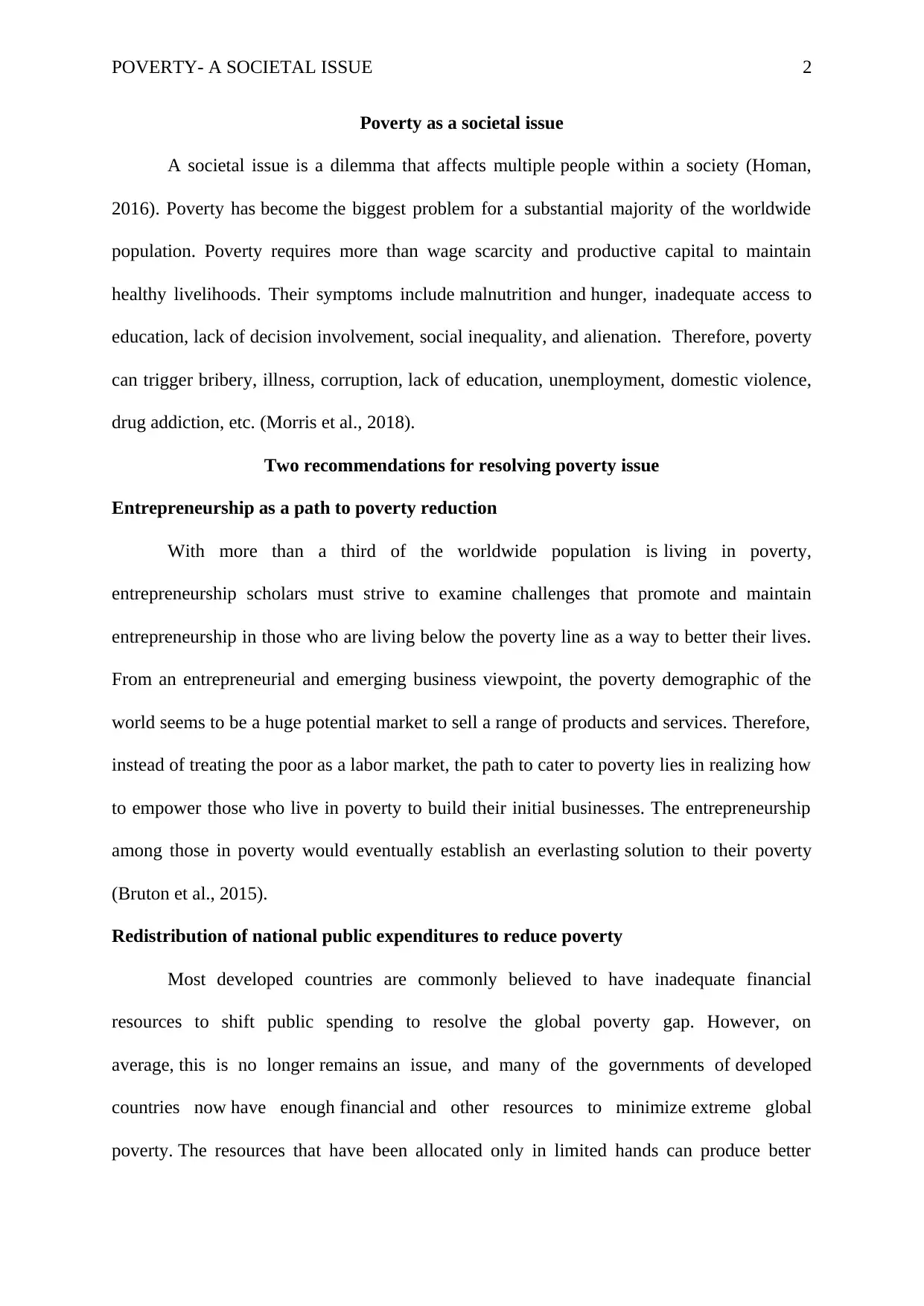
POVERTY- A SOCIETAL ISSUE 2
Poverty as a societal issue
A societal issue is a dilemma that affects multiple people within a society (Homan,
2016). Poverty has become the biggest problem for a substantial majority of the worldwide
population. Poverty requires more than wage scarcity and productive capital to maintain
healthy livelihoods. Their symptoms include malnutrition and hunger, inadequate access to
education, lack of decision involvement, social inequality, and alienation. Therefore, poverty
can trigger bribery, illness, corruption, lack of education, unemployment, domestic violence,
drug addiction, etc. (Morris et al., 2018).
Two recommendations for resolving poverty issue
Entrepreneurship as a path to poverty reduction
With more than a third of the worldwide population is living in poverty,
entrepreneurship scholars must strive to examine challenges that promote and maintain
entrepreneurship in those who are living below the poverty line as a way to better their lives.
From an entrepreneurial and emerging business viewpoint, the poverty demographic of the
world seems to be a huge potential market to sell a range of products and services. Therefore,
instead of treating the poor as a labor market, the path to cater to poverty lies in realizing how
to empower those who live in poverty to build their initial businesses. The entrepreneurship
among those in poverty would eventually establish an everlasting solution to their poverty
(Bruton et al., 2015).
Redistribution of national public expenditures to reduce poverty
Most developed countries are commonly believed to have inadequate financial
resources to shift public spending to resolve the global poverty gap. However, on
average, this is no longer remains an issue, and many of the governments of developed
countries now have enough financial and other resources to minimize extreme global
poverty. The resources that have been allocated only in limited hands can produce better
Poverty as a societal issue
A societal issue is a dilemma that affects multiple people within a society (Homan,
2016). Poverty has become the biggest problem for a substantial majority of the worldwide
population. Poverty requires more than wage scarcity and productive capital to maintain
healthy livelihoods. Their symptoms include malnutrition and hunger, inadequate access to
education, lack of decision involvement, social inequality, and alienation. Therefore, poverty
can trigger bribery, illness, corruption, lack of education, unemployment, domestic violence,
drug addiction, etc. (Morris et al., 2018).
Two recommendations for resolving poverty issue
Entrepreneurship as a path to poverty reduction
With more than a third of the worldwide population is living in poverty,
entrepreneurship scholars must strive to examine challenges that promote and maintain
entrepreneurship in those who are living below the poverty line as a way to better their lives.
From an entrepreneurial and emerging business viewpoint, the poverty demographic of the
world seems to be a huge potential market to sell a range of products and services. Therefore,
instead of treating the poor as a labor market, the path to cater to poverty lies in realizing how
to empower those who live in poverty to build their initial businesses. The entrepreneurship
among those in poverty would eventually establish an everlasting solution to their poverty
(Bruton et al., 2015).
Redistribution of national public expenditures to reduce poverty
Most developed countries are commonly believed to have inadequate financial
resources to shift public spending to resolve the global poverty gap. However, on
average, this is no longer remains an issue, and many of the governments of developed
countries now have enough financial and other resources to minimize extreme global
poverty. The resources that have been allocated only in limited hands can produce better
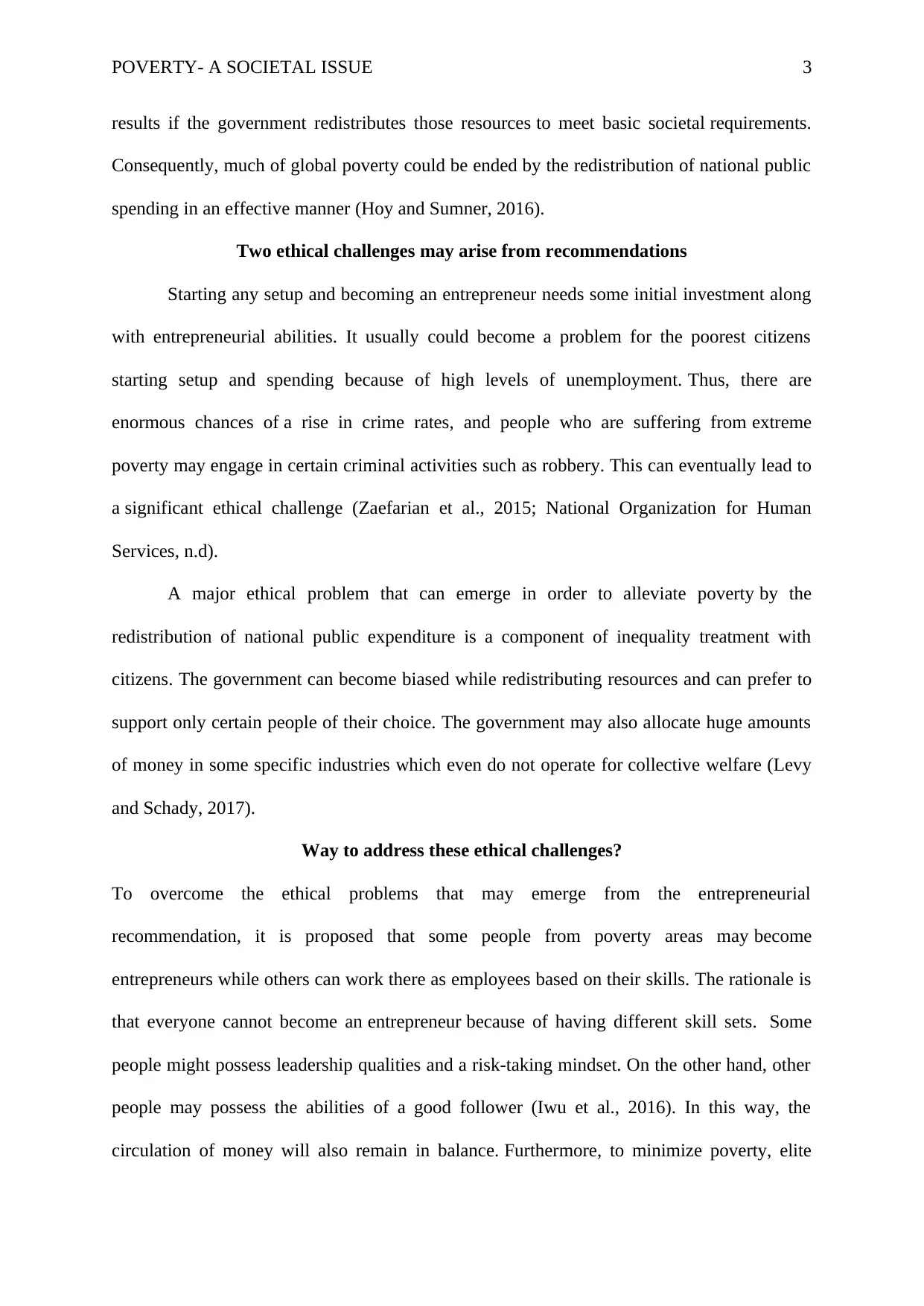
POVERTY- A SOCIETAL ISSUE 3
results if the government redistributes those resources to meet basic societal requirements.
Consequently, much of global poverty could be ended by the redistribution of national public
spending in an effective manner (Hoy and Sumner, 2016).
Two ethical challenges may arise from recommendations
Starting any setup and becoming an entrepreneur needs some initial investment along
with entrepreneurial abilities. It usually could become a problem for the poorest citizens
starting setup and spending because of high levels of unemployment. Thus, there are
enormous chances of a rise in crime rates, and people who are suffering from extreme
poverty may engage in certain criminal activities such as robbery. This can eventually lead to
a significant ethical challenge (Zaefarian et al., 2015; National Organization for Human
Services, n.d).
A major ethical problem that can emerge in order to alleviate poverty by the
redistribution of national public expenditure is a component of inequality treatment with
citizens. The government can become biased while redistributing resources and can prefer to
support only certain people of their choice. The government may also allocate huge amounts
of money in some specific industries which even do not operate for collective welfare (Levy
and Schady, 2017).
Way to address these ethical challenges?
To overcome the ethical problems that may emerge from the entrepreneurial
recommendation, it is proposed that some people from poverty areas may become
entrepreneurs while others can work there as employees based on their skills. The rationale is
that everyone cannot become an entrepreneur because of having different skill sets. Some
people might possess leadership qualities and a risk-taking mindset. On the other hand, other
people may possess the abilities of a good follower (Iwu et al., 2016). In this way, the
circulation of money will also remain in balance. Furthermore, to minimize poverty, elite
results if the government redistributes those resources to meet basic societal requirements.
Consequently, much of global poverty could be ended by the redistribution of national public
spending in an effective manner (Hoy and Sumner, 2016).
Two ethical challenges may arise from recommendations
Starting any setup and becoming an entrepreneur needs some initial investment along
with entrepreneurial abilities. It usually could become a problem for the poorest citizens
starting setup and spending because of high levels of unemployment. Thus, there are
enormous chances of a rise in crime rates, and people who are suffering from extreme
poverty may engage in certain criminal activities such as robbery. This can eventually lead to
a significant ethical challenge (Zaefarian et al., 2015; National Organization for Human
Services, n.d).
A major ethical problem that can emerge in order to alleviate poverty by the
redistribution of national public expenditure is a component of inequality treatment with
citizens. The government can become biased while redistributing resources and can prefer to
support only certain people of their choice. The government may also allocate huge amounts
of money in some specific industries which even do not operate for collective welfare (Levy
and Schady, 2017).
Way to address these ethical challenges?
To overcome the ethical problems that may emerge from the entrepreneurial
recommendation, it is proposed that some people from poverty areas may become
entrepreneurs while others can work there as employees based on their skills. The rationale is
that everyone cannot become an entrepreneur because of having different skill sets. Some
people might possess leadership qualities and a risk-taking mindset. On the other hand, other
people may possess the abilities of a good follower (Iwu et al., 2016). In this way, the
circulation of money will also remain in balance. Furthermore, to minimize poverty, elite
⊘ This is a preview!⊘
Do you want full access?
Subscribe today to unlock all pages.

Trusted by 1+ million students worldwide
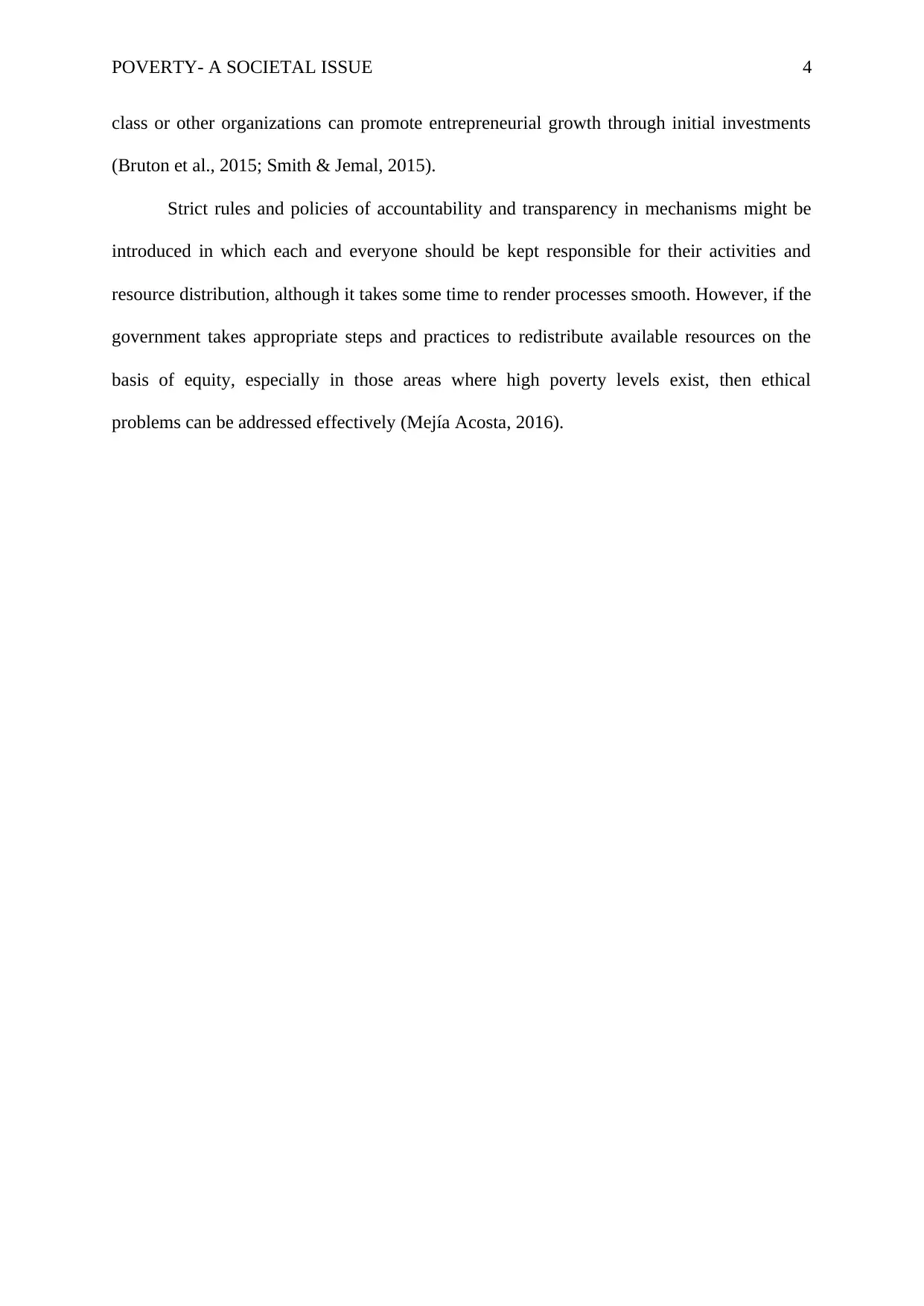
POVERTY- A SOCIETAL ISSUE 4
class or other organizations can promote entrepreneurial growth through initial investments
(Bruton et al., 2015; Smith & Jemal, 2015).
Strict rules and policies of accountability and transparency in mechanisms might be
introduced in which each and everyone should be kept responsible for their activities and
resource distribution, although it takes some time to render processes smooth. However, if the
government takes appropriate steps and practices to redistribute available resources on the
basis of equity, especially in those areas where high poverty levels exist, then ethical
problems can be addressed effectively (Mejía Acosta, 2016).
class or other organizations can promote entrepreneurial growth through initial investments
(Bruton et al., 2015; Smith & Jemal, 2015).
Strict rules and policies of accountability and transparency in mechanisms might be
introduced in which each and everyone should be kept responsible for their activities and
resource distribution, although it takes some time to render processes smooth. However, if the
government takes appropriate steps and practices to redistribute available resources on the
basis of equity, especially in those areas where high poverty levels exist, then ethical
problems can be addressed effectively (Mejía Acosta, 2016).
Paraphrase This Document
Need a fresh take? Get an instant paraphrase of this document with our AI Paraphraser
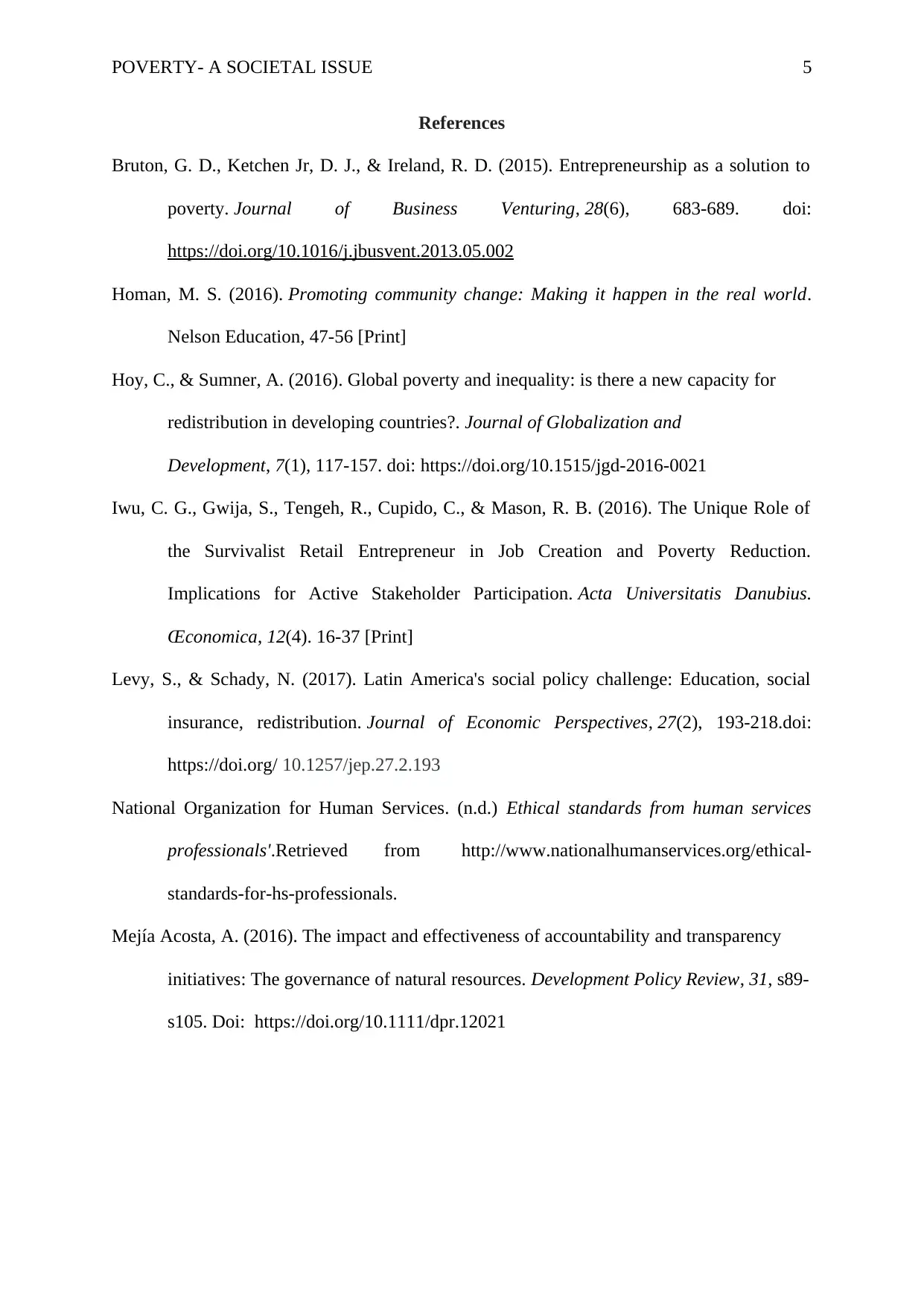
POVERTY- A SOCIETAL ISSUE 5
References
Bruton, G. D., Ketchen Jr, D. J., & Ireland, R. D. (2015). Entrepreneurship as a solution to
poverty. Journal of Business Venturing, 28(6), 683-689. doi:
https://doi.org/10.1016/j.jbusvent.2013.05.002
Homan, M. S. (2016). Promoting community change: Making it happen in the real world.
Nelson Education, 47-56 [Print]
Hoy, C., & Sumner, A. (2016). Global poverty and inequality: is there a new capacity for
redistribution in developing countries?. Journal of Globalization and
Development, 7(1), 117-157. doi: https://doi.org/10.1515/jgd-2016-0021
Iwu, C. G., Gwija, S., Tengeh, R., Cupido, C., & Mason, R. B. (2016). The Unique Role of
the Survivalist Retail Entrepreneur in Job Creation and Poverty Reduction.
Implications for Active Stakeholder Participation. Acta Universitatis Danubius.
Œconomica, 12(4). 16-37 [Print]
Levy, S., & Schady, N. (2017). Latin America's social policy challenge: Education, social
insurance, redistribution. Journal of Economic Perspectives, 27(2), 193-218.doi:
https://doi.org/ 10.1257/jep.27.2.193
National Organization for Human Services. (n.d.) Ethical standards from human services
professionals'.Retrieved from http://www.nationalhumanservices.org/ethical-
standards-for-hs-professionals.
Mejía Acosta, A. (2016). The impact and effectiveness of accountability and transparency
initiatives: The governance of natural resources. Development Policy Review, 31, s89-
s105. Doi: https://doi.org/10.1111/dpr.12021
References
Bruton, G. D., Ketchen Jr, D. J., & Ireland, R. D. (2015). Entrepreneurship as a solution to
poverty. Journal of Business Venturing, 28(6), 683-689. doi:
https://doi.org/10.1016/j.jbusvent.2013.05.002
Homan, M. S. (2016). Promoting community change: Making it happen in the real world.
Nelson Education, 47-56 [Print]
Hoy, C., & Sumner, A. (2016). Global poverty and inequality: is there a new capacity for
redistribution in developing countries?. Journal of Globalization and
Development, 7(1), 117-157. doi: https://doi.org/10.1515/jgd-2016-0021
Iwu, C. G., Gwija, S., Tengeh, R., Cupido, C., & Mason, R. B. (2016). The Unique Role of
the Survivalist Retail Entrepreneur in Job Creation and Poverty Reduction.
Implications for Active Stakeholder Participation. Acta Universitatis Danubius.
Œconomica, 12(4). 16-37 [Print]
Levy, S., & Schady, N. (2017). Latin America's social policy challenge: Education, social
insurance, redistribution. Journal of Economic Perspectives, 27(2), 193-218.doi:
https://doi.org/ 10.1257/jep.27.2.193
National Organization for Human Services. (n.d.) Ethical standards from human services
professionals'.Retrieved from http://www.nationalhumanservices.org/ethical-
standards-for-hs-professionals.
Mejía Acosta, A. (2016). The impact and effectiveness of accountability and transparency
initiatives: The governance of natural resources. Development Policy Review, 31, s89-
s105. Doi: https://doi.org/10.1111/dpr.12021
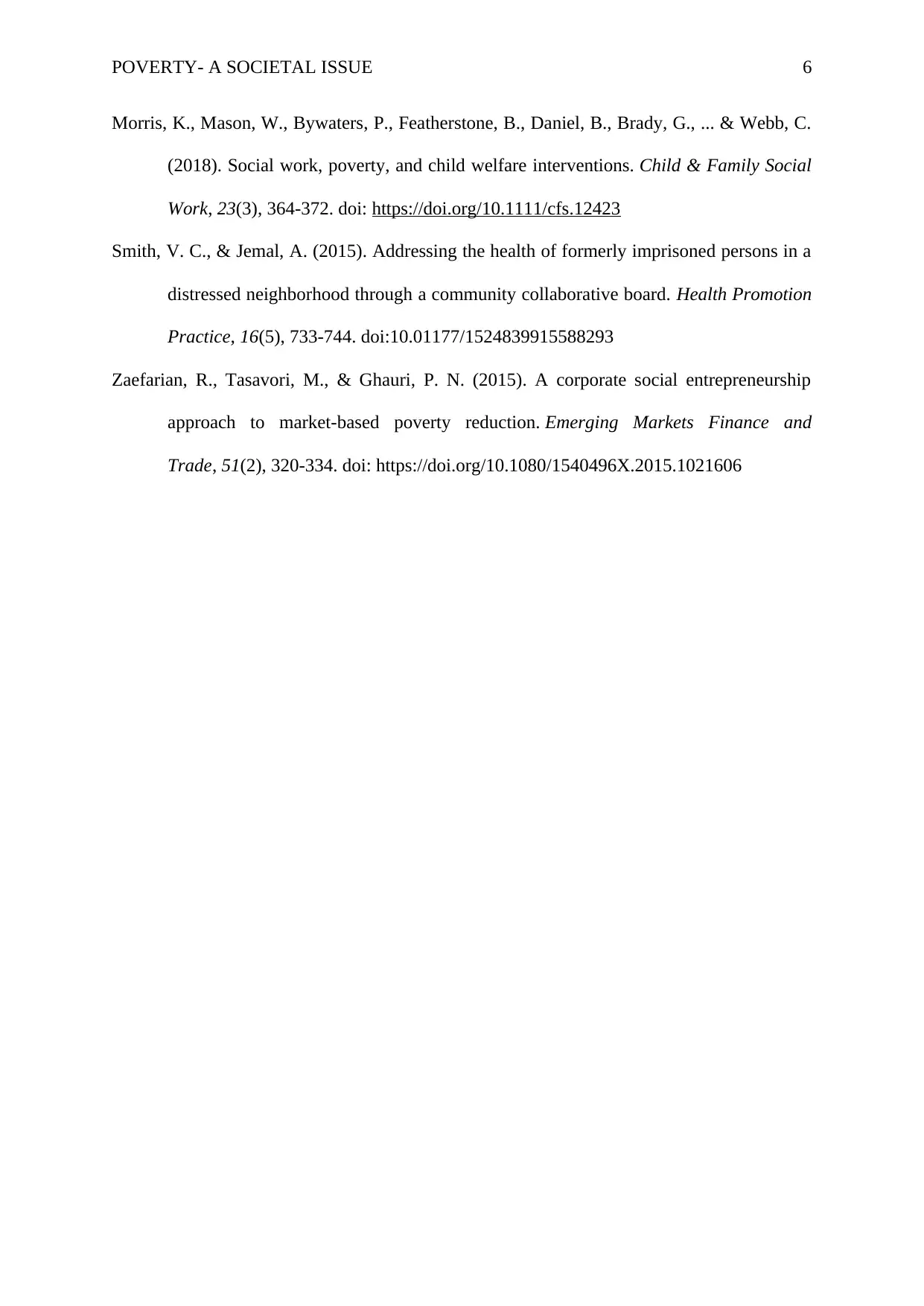
POVERTY- A SOCIETAL ISSUE 6
Morris, K., Mason, W., Bywaters, P., Featherstone, B., Daniel, B., Brady, G., ... & Webb, C.
(2018). Social work, poverty, and child welfare interventions. Child & Family Social
Work, 23(3), 364-372. doi: https://doi.org/10.1111/cfs.12423
Smith, V. C., & Jemal, A. (2015). Addressing the health of formerly imprisoned persons in a
distressed neighborhood through a community collaborative board. Health Promotion
Practice, 16(5), 733-744. doi:10.01177/1524839915588293
Zaefarian, R., Tasavori, M., & Ghauri, P. N. (2015). A corporate social entrepreneurship
approach to market-based poverty reduction. Emerging Markets Finance and
Trade, 51(2), 320-334. doi: https://doi.org/10.1080/1540496X.2015.1021606
Morris, K., Mason, W., Bywaters, P., Featherstone, B., Daniel, B., Brady, G., ... & Webb, C.
(2018). Social work, poverty, and child welfare interventions. Child & Family Social
Work, 23(3), 364-372. doi: https://doi.org/10.1111/cfs.12423
Smith, V. C., & Jemal, A. (2015). Addressing the health of formerly imprisoned persons in a
distressed neighborhood through a community collaborative board. Health Promotion
Practice, 16(5), 733-744. doi:10.01177/1524839915588293
Zaefarian, R., Tasavori, M., & Ghauri, P. N. (2015). A corporate social entrepreneurship
approach to market-based poverty reduction. Emerging Markets Finance and
Trade, 51(2), 320-334. doi: https://doi.org/10.1080/1540496X.2015.1021606
⊘ This is a preview!⊘
Do you want full access?
Subscribe today to unlock all pages.

Trusted by 1+ million students worldwide
1 out of 6
Your All-in-One AI-Powered Toolkit for Academic Success.
+13062052269
info@desklib.com
Available 24*7 on WhatsApp / Email
![[object Object]](/_next/static/media/star-bottom.7253800d.svg)
Unlock your academic potential
Copyright © 2020–2025 A2Z Services. All Rights Reserved. Developed and managed by ZUCOL.


